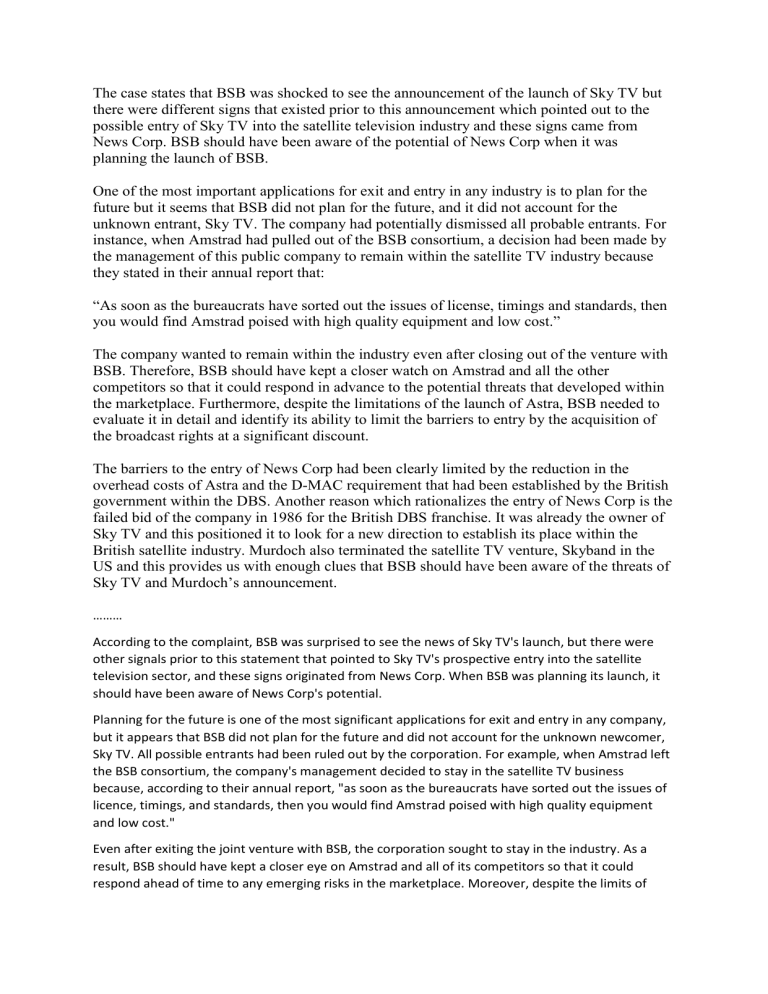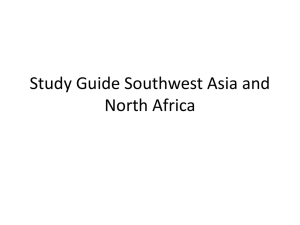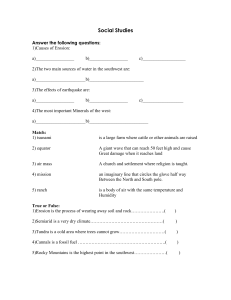BSB vs Sky TV & Southwest Airlines Case Study Analysis
advertisement

The case states that BSB was shocked to see the announcement of the launch of Sky TV but there were different signs that existed prior to this announcement which pointed out to the possible entry of Sky TV into the satellite television industry and these signs came from News Corp. BSB should have been aware of the potential of News Corp when it was planning the launch of BSB. One of the most important applications for exit and entry in any industry is to plan for the future but it seems that BSB did not plan for the future, and it did not account for the unknown entrant, Sky TV. The company had potentially dismissed all probable entrants. For instance, when Amstrad had pulled out of the BSB consortium, a decision had been made by the management of this public company to remain within the satellite TV industry because they stated in their annual report that: “As soon as the bureaucrats have sorted out the issues of license, timings and standards, then you would find Amstrad poised with high quality equipment and low cost.” The company wanted to remain within the industry even after closing out of the venture with BSB. Therefore, BSB should have kept a closer watch on Amstrad and all the other competitors so that it could respond in advance to the potential threats that developed within the marketplace. Furthermore, despite the limitations of the launch of Astra, BSB needed to evaluate it in detail and identify its ability to limit the barriers to entry by the acquisition of the broadcast rights at a significant discount. The barriers to the entry of News Corp had been clearly limited by the reduction in the overhead costs of Astra and the D-MAC requirement that had been established by the British government within the DBS. Another reason which rationalizes the entry of News Corp is the failed bid of the company in 1986 for the British DBS franchise. It was already the owner of Sky TV and this positioned it to look for a new direction to establish its place within the British satellite industry. Murdoch also terminated the satellite TV venture, Skyband in the US and this provides us with enough clues that BSB should have been aware of the threats of Sky TV and Murdoch’s announcement. ……… According to the complaint, BSB was surprised to see the news of Sky TV's launch, but there were other signals prior to this statement that pointed to Sky TV's prospective entry into the satellite television sector, and these signs originated from News Corp. When BSB was planning its launch, it should have been aware of News Corp's potential. Planning for the future is one of the most significant applications for exit and entry in any company, but it appears that BSB did not plan for the future and did not account for the unknown newcomer, Sky TV. All possible entrants had been ruled out by the corporation. For example, when Amstrad left the BSB consortium, the company's management decided to stay in the satellite TV business because, according to their annual report, "as soon as the bureaucrats have sorted out the issues of licence, timings, and standards, then you would find Amstrad poised with high quality equipment and low cost." Even after exiting the joint venture with BSB, the corporation sought to stay in the industry. As a result, BSB should have kept a closer eye on Amstrad and all of its competitors so that it could respond ahead of time to any emerging risks in the marketplace. Moreover, despite the limits of Astra's launch, BSB needed to thoroughly assess it and determine its ability to lower entry barriers by acquiring broadcast rights at a large discount. The reduction in Astra's overhead costs and the D-MAC requirement enforced by the British government within the DBS had obviously constrained News Corp's ability to enter the market. Another reason for News Corp's participation is the company's unsuccessful attempt for the British DBS franchise in 1986. It already owned Sky TV, therefore it was in a good position to find a new way to establish itself in the British satellite market. Murdoch also shut down Skyband, a satellite TV venture in the United States, which gives us enough evidence that BSB was aware of Sky TV's threats and Murdoch's declaration. Since new regulations and directives were implemented particularly from baggage inspection to security searches, delays would naturally occur especially because Southwest passengers are accustomed to coming in last minute. Therefore, management should respond constructively to this statistic by proposing a new policy to its passengers regarding arrival. They could impose that they (especially those with heavy luggage) be at the airport ahead of time (e.g. an hour) before departure given the lengthy procedures on security. This could be easily justified to passengers as having implications on their own safety as well. Of course, Southwest could also use a technological solution to this problem which they have recently done-an electronic check-in system via Southwest.com which would save passengers’ time by allowing them to board without having to check with an agent. Since new laws and instructions, ranging from baggage screening to security searches, delays are unavoidable, especially because Southwest travellers are accustomed to arriving at the last minute. As a result, management should respond positively to this data by suggesting a new arrival policy to its passengers. Given the lengthy security processes, they could require that individuals (especially those with big bags) arrive at the airport early (e.g. an hour) before departure. Passengers could easily justify this by claiming that it affects their personal safety. Southwest could, of course, apply a technological solution to this problem, such as an electronic check-in system via Southwest.com, which would save passengers time by allowing them to board without having to check in with an agent. Southwest offered unique alternatives in response to competitors who clearly wanted to engage in price wars. Southwest did engage in price wars (e.g., with Braniff International with its $13 offer), but it competed not merely on the basis of price but also of value proposition (e.g. giving incentive in the form of gifts to customers who paid $26 instead of $13). These alternatives were embraced by Southwest passengers. Southwest was very successful at cost reduction measures whilst competitors struggled to make their own measures as effective. The reduction of turnaround time and innovation in other operational processes (e.g., Automated ticketing) also paid off for Southwest in this regard. More notably, Southwest negotiated the price of its fuel to suppliers, thereby saving several more millions. Innovations were not limited to operational processes. They implemented promotional programs (e.g., frequent-flier program which was the world’s first) that entice customers and give them more reasons to keep coming back. As Michael Porter himself said, Southwest’s strategy involves a whole system of activities and not merely a connection of parts. The airline’s processes are closely-knit together such that they complement each other making it systematic and more importantly very hard to imitate. Competitors clearly could not expect to win on the basis of imitation. In response to competitors that plainly intended to engage in price wars, Southwest offered new alternatives. Southwest did compete on price (for example, with Braniff International's $13 offer), but it also competed on value proposition (for example, offering incentives in the form of presents to clients who paid $26 instead of $13). Passengers on Southwest were enthusiastic about these options. While competitors failed to make their own cost-cutting measures as effective as Southwest's, competitors struggled to make their own measures as effective as Southwest's. Southwest has benefited from the reduction in turnaround time and innovation in other operational procedures ( for example, automated ticketing). Southwest, in particular, bargained the price of its gasoline with suppliers, saving millions of dollars. Operational processes were not the only areas where innovations were made. They established promotional programmes (such as the world's first frequent-flier programme) to lure clients and offer them more reasons to return. Southwest's strategy, according to Michael Porter, entails a "complete system of activity," not just a "connection of pieces." The airline's processes are intertwined in such a way that they complement one another, making it systematic and, more significantly, difficult to copy. It was evident that competitors could not expect to succeed by copying.


